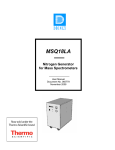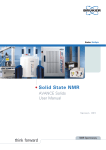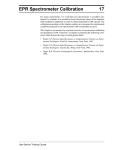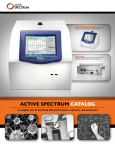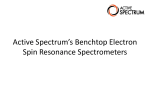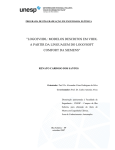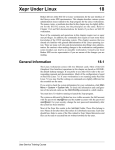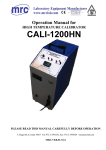Download EMX ER 4141 VT USER`S MANUAL
Transcript
EMX ER 4141 VT USER’S MANUAL EMX User’s Guide for the ER 4141VT Variable Temperature Accessory EPR Division Bruker Instruments, Inc. Billerica, MA USA EMX User’s Guide for the ER4141VT Variable Temperature Accessory Manual Version 1.0 Copyright © 2006 Bruker BioSpin Corporation The text, figures, and programs have been worked out with the utmost care. However, we cannot accept either legal responsibility or any liability for any incorrect statements which may remain, and their consequences. The following publication is protected by copyright. All rights reserved. No part of this publication may be reproduced in any form by photocopy, microfilm or other procedures or transmitted in a usable language for machines, in particular data processing systems without our written authorization. The rights of reproduction through lectures, radio and television are also reserved. The software and hardware descriptions referred in this manual are in many cases registered trademarks and as such are subject to legal requirements. This manual is part of the original documentation for the Bruker ER 4141VT variable temperature unit. Preface 0 Bruker strives to supply you with instructional and accurate documentation. We encourage you to tell us how we are doing. Please send us your suggestions for improvements, corrections, or bug reports. If there is anything you particularly liked, tell us as well. With your input and assistance, Bruker can continually improve its products and documentation. You can send your messages and correspondence via e-mail, FAX, telephone, or mail. It is important to include the document name, product name, version number, and page number in your response. Here are the addresses and numbers to which you can send your messages. e-mail: [email protected] FAX: 978-670-8851 Tel. 978-663-7406 mailing address EPR Division Bruker BioSpin Corp. 44 Manning Rd. Manning Park Billerica, MA 01821 USA Thank you for your help. EMX ER 4141VT User’s manual 0-iv Table of Contents 0.1 0 Preface ............................................................................................ 0-iii 0.1 Table of Contents.........................................................................................................0-v 1 Introduction .......................................................................................1-1 1.1 Principle of Operation..................................................................................................1-2 1.2 Safety ...........................................................................................................................1-3 1.3 Using this Manual........................................................................................................1-4 1.3.1 Chapter Descriptions ........................................................................................................ 1-4 1.3.2 Typographical Conventions.............................................................................................. 1-4 2 Getting Started .................................................................................2-1 2.1 2.2 2.3 2.4 2.5 Assemble the Cryostat .................................................................................................2-6 Connect the Transfer Line to the Cryostat...................................................................2-9 Make Connections to the Front Panel........................................................................2-11 Evaporator Setup........................................................................................................2-13 Verify that the System is Set up Properly..................................................................2-15 3 Basic Experiments ............................................................................3-1 3.1 Multiple Field Sweeps at One Temperature ................................................................3-2 3.2 Temperature Sweep Experiment..................................................................................3-4 3.3 Above Room Temperature Experiments .....................................................................3-7 4 Helpful Hints .....................................................................................4-1 4.1 PID Settings Table .......................................................................................................4-2 4.2 Wide Range Temperatures Sweeps .............................................................................4-3 4.3 Narrow Range Temperature Sweeps ...........................................................................4-4 5 Troubleshooting ................................................................................5-1 EMX ER 4141VT User’s manual v vi Introduction 1 Congratulations on the purchase of your Bruker ER 4141VT variable temperature accessory. The ER 4141VT is designed to give you automated precise control of your EPR sample’s temperature. If cared for properly, the system will provide you with many years of excellent service. The ER 4141VT will interface with either the EMX or ELEXSYS spectrometer software, both of which provide easy point and click control of all temperature relevant parameters. The goal of this manual is to provide a convenient user guide that you can refer during operation. Some technical aspects are discussed but these are kept to a minimum as they are described in the technical reference manual provided with the accessory. Also included with this manual is the WIN-EPR CD ROM which contains an animation demonstrating the assembly of a liquid nitrogen variable temperature accessory. To view this animation on your PC, first insert the CD ROM into your CD ROM drive. From “Windows Explorer” double click the Aawin.exe icon. This will open the software for viewing the animation. Next, select load script under the File drop down menu. Select the file “Bruker.aas” from the /FLICS/ sub-directory. Click the play button to begin the animation. The animation will show the insertion of aqueous flat cells (which may or may not be of use to you) and then the assembly of a liquid nitrogen variable temperature accessory. EMX ER 4141VT User’s manual Principle of Operation Principle of Operation 1.1 The ER 4141VT is a variable temperature accessory designed to regulate the temperature of your sample between 120 K and 1273 K. For temperatures above 520 K, you need an additional power booster and a high temperature cavity. Temperature control is achieved using the combined actions of a liquid nitrogen evaporator, a heater, and the ER 4141 controller. The evaporator boils liquid nitrogen from a large dewar. Cold nitrogen gas flows from the dewar through a transfer line into the cavity’s cryostat where the sample is placed. A thermocouple placed near the sample is used to measure the temperature of the flowing gas. The ER 4141 controller then compares the temperature indicated by the thermocouple with that programmed by the user and adjusts the voltage of the heater such that the gas flowing by the sample is warmed to the desired temperature. 1-2 Safety Safety 1.2 Improper technique when handling cryogens and cryogenic equipment can result in serious injury. Please note the list of safety tips below. 1. Always wear a face shield (or at least safety goggles) and cryogenic gloves when pouring, transferring, or transporting cryogens. 2. Always use a lid on dewars when carrying cryogens. To prevent the build up of liquid oxygen, you should also store your liquid nitrogen with an adequately vented lid in place. 3. When inserting objects (e.g., sample tubes) that are at room temperature into a cryogen, do it very slowly to avoid violent boil-off of the cryogen and or breakage of the tube. Always wear safety glasses! 4. When removing sample tubes or other enclosed objects from the cryogen be aware that they may explode or that the lid may come off with considerable force. (Always wear safety glasses!) Air condenses in your sample tube when you cool it to liquid nitrogen temperature. It then expands rapidly when warmed, which can cause the tube to explode. EMX ER 4141VT User’s manual 1-3 Using this Manual Using this Manual Chapter Descriptions 1.3 1.3.1 To make this manual more useful, it has been divided into four sections. You may only need to refer to one of these sections at a given time, so the following descriptions of the chapters will guide you to the right section. Chapter 2 Getting Started - “I’ve just received my ER4131VT from Bruker. Now what do I do?” This chapter makes the assumption that you are totally unfamiliar with Bruker temperature accessories and takes you through the steps of identifying parts, setting up the cryogenic equipment with your cavity, interfacing the ER 4141 controller with your computer, and most importantly making sure everything works properly! Chapter 3 Basic Experiments - “OK, everything seems to be working, now I need to collect some data.” This chapter describes how to program your ER 4141 controller to perform temperature sweep experiments with the EMX software. Examples of common experiments are provided. A basic temperature sweep experiment is outlined and hints for optimizing your system for specific types of experiments is discussed. Chapter 4 Helpful hints - “The basic experiments work well, but how do I optimize my ER 4141 controller and EMX to perform a more difficult experiment?” This chapter will give you some hints to optimize your system to meet the challenges of the more difficult experiments. Chapter 5 Troubleshooting - “Help...my ER4131VT isn’t working and I’ve got lots of experiments to do!” This chapter reviews the most common problems that occur and provides solutions that will get you back to your work in the least amount of time. Typographical Conventions 1.3.2 Special fonts are used in the text to differentiate between normal manual text and text displayed in the software. Times Helvetica 1-4 This is the font used for the normal text in the manual. This is the font used for text that is displayed by the software or must be entered into the program by you. Getting Started 2 The ER 4141VT is available with two slightly different accessory kits. The type A kit is shown in Figure 2-1, while the type B kit is shown in Figure 2-2. Identify your kit by referring to these figures. Then use the appropriate figure to refer to parts during the assembly process. Your cryostat may be slightly different from that pictured below. Note that, for shipping purposes, some of the plastic fittings may already be threaded into the dewar insert holder. At this point, unscrew each of the plastic fittings and refer to either Figure 2-1 or Figure 2-2. EMX ER 4141VT User’s manual E D B C A I J F P O V U H M G L R T S N Figure 2-1 2-2 K Q Components of Type A variable temperature kit. A. Power cable B. LegrisTM tubing for gas in/gas out C. Liquid nitrogen refill fitting D. Adapter and tubing for above room temperature applications. E. Serial interface cable (number of pins may vary) F. Ring bracket assembly for liquid nitrogen evaporator G. Liquid nitrogen evaporator H. U-adapter for transfer line (used with 6” and 8” magnets) I. Transfer line J. Transfer line support K. Dewar insert holder L. Quartz dewar insert M. Plastic sleeve for dewar insert N. Upper VT collet adapter O. Plastic locking ring for Upper VT collet adapter P. Ground glass stopper for nitrogen refill opening Q. Thermocouple mounting screw R. Heater S. Thermocouple T. Tube roller for vacuum grease U. Vacuum grease V. Nozzle for vacuum grease EMX ER 4141VT User’s manual 2-3 E D B C A I J P V O U F M S T 2-4 L K N Figure 2-2 H Q R Components for Type B variable temperature kit. G A. Power cable B. LegrisTM tubing for gas in/gas out C. Liquid nitrogen refill fitting D. Adapter and tubing for above room temperature applications E. Serial interface cable (number of pins may vary) F. Ring bracket assembly for liquid nitrogen evaporator G. Liquid nitrogen evaporator H. U-adapter for transfer line (used only with 6” and 8” magnets I. Transfer line J. Transfer line support K. Dewar insert holder L. Quartz dewar insert M. Plastic sleeve for dewar insert N. Upper VT collet adapter O. Plastic locking ring for upper VT collet adapter P. Ground glass stopper for nitrogen refill opening Q. Heater/thermocouple mounting screw R. Rubber gasket for heater/thermocouple S. Heater/Thermocouple assembly T. Tube roller for vacuum grease U. Vacuum grease V. Nozzle for vacuum grease EMX ER 4141VT User’s manual 2-5 Assemble the Cryostat Assemble the Cryostat It is a good idea to assemble the cryostat on a large flat surface to minimize the chance of breaking the quartz ware. 2.1 1. Insert the quartz dewar into the dewar insert holder. (See Figure 2-3.) Slide the white plastic sleeve (part M) over the long neck of the dewar insert (part L) and place it into the dewar insert holder (part K). 2. For the type A kit: thread the thermocouple mounting screw onto the cryostat body. Thread the thermocouple mounting screw (part Q) onto the bottom of the dewar insert holder (part K). (See Figure 2-3.) 3. For the type B kit: thread the heater mounting screw and rubber gasket onto the dewar insert holder. First, slide the plastic mounting screw and rubber gasket (parts Q and R) over the heater/thermocouple (part S) all the way to the bottom (mounting screw first). Next, thread the mounting screw onto the bottom of the cryostat body until the rubber gasket presses against the bottom of the dewar insert. Then gently pull the heater/thermocouple assembly out of the cryostat. Assembling in this way assures that the holes in the mounting screw, rubber gasket and dewar insert are lined up properly. (See Figure 2-4.) Part K Part M Dewar insert Part L Part Q Part S 2-6 Assemble the Cryostat Figure 2-3 Assembling the cryostat for the type A kit. Part K Part M Dewar insert Part L Part R Part Q Part S Figure 2-4 4. Assembling the cryostat for the type B kit. Connect the cryostat to your cavity. (See Figure 2-5.) Remove the collet nuts and white plastic collets from your cavity. Carefully insert the quartz end of the cryostat assembly upwards through the bottom of your cavity. Screw the lower retaining nut of the dewar insert holder onto the collet stack of your cavity. (Do not over tighten.) EMX ER 4141VT User’s manual 2-7 Assemble the Cryostat 5. Fit the sample holder assembly onto your cavity. Slide a large diameter plastic collet over the dewar insert and into the collet stack of your cavity. This will protect the quartz from breakage. Next, screw the upper VT collet adapter (part N) onto the collet stack of your cavity. Place a sample collet that is appropriately sized for your sample tube into the recession of the upper VT collet adapter. Screw a standard collet nut onto the upper VT collet adapter. 6. Insert the Heater/Thermocouple assembly into the cryostat. Carefully push the heater and/or thermocouple (part S) into the hole of the heater mounting screw. You will need to apply firm, yet gentle pressure to get a good fit. Attach the grounding strap to the side of the dewar insert holder using the brass grounding screw. Collet nut Collets Part N Lower retaining nut Part K Grounding strap Part S Figure 2-5 2-8 Attaching the cryostat to the cavity. Grounding screw Connect the Transfer Line to the Cryostat Connect the Transfer Line to the Cryostat 2.2 1. Connect the cavity to the microwave bridge. After you have attached the cryostat to the cavity, connect the waveguide of your cavity to the waveguide from your microwave bridge. 2. Install the transfer line support. Screw the transfer line support (part J) into the hole in the rear portion of the base of your magnet. Loosen the brass locking screw and adjust the shaft of the transfer line support until the U-shaped bracket is about even with the ground glass ball joint on your cryostat. 3. Insert the heater or ground glass stopper into the transfer line. If you have a type A kit, insert the heater into the transfer line and secure it in place using the spring clips provided. If you have the type B accessory kit, insert the ground glass stopper into the open end of the transfer line and secure it in place using the spring clips. 4. Connect the transfer line. Put a small amount of the vacuum grease (part U) on both ground glass joints of the transfer line (part I). Match the recessed joint from the straight end of the transfer line onto the ball joint of the cryostat. Push the bayonet connector toward the cryostat. You will feel the springs of the connector compress. Then turn the connector about 1/4 turn clockwise and release. You will feel the connector click into place. Gently pull outward on the transfer line to ensure the connection was made. Next, pull the spring clip over the transfer line and attach it to the opposite side of the U-shaped bracket. (See Figure 2-6.) EMX ER 4141VT User’s manual 2-9 Connect the Transfer Line to the Cryostat 5. Adjust the transfer line support. The shaft of the transfer line should be resting in the U-shaped fitting of the support. Adjust the support height using the brass locking screw so that the transfer line is parallel with the floor. Spring Clip Bayonet connector Transfer line Transfer line support Figure 2-6 2-10 Attaching the transfer line to the cavity. Make Connections to the Front Panel Make Connections to the Front Panel 2.3 At this point it is a good idea to connect all cables and gas flow tubing to the controller so it will be ready when you initiate the flow of cold nitrogen gas. 1. Connect the power cable (part A) to a 208-240 V outlet. Connect the female end of the power cable to the rear of the ER 4141 controller and the other end to an outlet supplying between 208 and 240 Volts. 2. Connect the Heater/Thermocouple cables (part S) to the ER 4141 controller. (See Figure 2-7.) Plug the eight pin heater connector into the port on the front panel labelled “Heater”. Then insert the thermocouple connector (three large pins) into the port labelled “Sensor”. 3. Connect the liquid nitrogen evaporator cable (part G) to the front of the ER 4141 controller. Place the evaporator assembly behind the magnet next to your liquid nitrogen storage dewar. Then connect the five pin connector to the port labeled “N2”. 4. Connect a length of tygon tubing from your dry nitrogen source to the back of the waveguide on your cavity. You will need a source of flowing dry nitrogen to prevent condensation from forming inside your cavity. EMX ER 4141VT User’s manual 2-11 Make Connections to the Front Panel Heater connection Ethernet connection Figure 2-7 2-12 LN2 evaporator connection Connection status LEDs Front panel connections for ER 4141 controller. Thermocouple connection Evaporator Setup Evaporator Setup 2.4 1. Attach the ring bracket (part F) to the liquid nitrogen storage dewar. The ring bracket comprises two parts, a split ring clamp for the storage dewar and a closed bracket that you put on top of the evaporator’s rubber stopper. Position the two pieces of the ring clamp around the neck of the storage dewar and insert the screws into the flanges on each side of the clamp. Thread the nut onto each screw and tighten the ring bracket onto the dewar neck (use a screw driver and a wrench.). Put the other part of the ring clamp on top of the rubber stopper for the evaporator. This will require that you work the cable from the evaporator through the circular hole of the bracket. 2. Insert the evaporator into the storage dewar that has been previously filled with liquid nitrogen. Wear a protective face shield or goggles and suitable gloves when performing this step. Very carefully begin slowly lowering the evaporator assembly (part G) into the nitrogen storage dewar. Inserting the evaporator too quickly, will cause the liquid nitrogen to boil violently and splash out of the dewar. Not only can this cause injury, but splashing liquid nitrogen onto the rubber stopper will cause it to freeze and will prevent you from getting a good seal between the stopper and the top of the liquid nitrogen dewar. When you get the evaporator completely inserted, push firmly on the rubber stopper portion of the evaporator assembly to ensure a good seal. Then use the hook shaped handles on the spring clips to insert the springs into the holes of the ring bracket (part F) on top of the rubber stopper. (See Figure 2-8.) You will notice cold gas coming out of the nitrogen refill opening in the top of the evaporator assembly. 3. Connect the transfer line to the evaporator assembly. (See Figure 2-8.) Position the evaporator and dewar assembly so that the recessed ground glass fitting is just underneath the ball fitting of the L-bend in the transfer line. Connect these two ground glass joints together. Pull the ring clips from the evaporator up and over the hook shaped fittings on the transfer line. If you have a 6 inch, 8 inch or 9 inch magnet, you will need to connect the U-shaped adapter (part H) to the transfer line. In this case the L-bend of the transfer line will point upwards and the fittings on the adapter will point toward the floor. (See Figure 2-8.) Connect the other end to the ground glass fitting in the evaporator. 4. Initiate cold gas flow to the cryostat. Insert the ground glass stopper (Part P) into the liquid nitrogen refill opening in the top of the evaporator assembly. As you insert the stopper you will initiate the flow of cold nitrogen gas to the cryostat. EMX ER 4141VT User’s manual 2-13 Evaporator Setup Part H Part I Part P Part G Part F Nitrogen Dewar Figure 2-8 2-14 For 10” magnets For 6” and 8” magnets Attaching the transfer line/evaporator assembly to your magnet. Verify that the System is Set up Properly Verify that the System is Set up Properly 2.5 Now that you have made all the connections and initiated the flow of cold nitrogen gas to the cryostat, you need to configure the software for your spectrometer and test the system. 1. Open the EMX Win Acquisition software. Make sure the EMX spectrometer is on before launching WIN Acquisition. When the software has opened, you will need to configure it for the ER 4141 controller. First close all spectrum windows. You will notice that the top menu bar changes to include the Setup window. Open the Setup drop-down menu and click on other Devices. Click the “Use VTU” check box. (See Figure 2-9.) Now when you close the dialog box the temperature reading should appear to the right of the receiver level indicator. Figure 2-9 2. Establishing communication between your PC and the ER 4141 controller using the other Devices dialog box. Open the Temperature Unit Control dialog box. You can access the Temperature Unit Control dialog box from two locations, either the Setup menu, or if you have a spectrum window open, you will find EMX ER 4141VT User’s manual 2-15 Verify that the System is Set up Properly it under the Parameters menu. When you open the dialog box the green bars for both the “Heater” and “LN2” should be green. Temperature Unit Control dialog box. Figure 2-10 3. 2-16 The Temperature Unit Control dialog box should appear as above. Check the ability of your ER 4141 controller to regulate temperature. Insert an empty sample tube into the cavity’s cryostat before performing steps 4 and 5. The set temperature will display the temperature value that was entered the previous time the software was used. Enter 295 K as the Set Temperature and turn on the Heater and the Evaporator Heater by clicking the On button for each unit in the Temperature Unit Controller dialog box. (See Figure 2-10.) The evaporator power should be set at about 20 if you are doing experiments between 200 and 300 K. Set it at 40 or 50 if you need to use low temperatures (i.e., below 150 K) for prolonged periods. See Table 2-1 for recommended power settings. Once the set temperature of 295 K has stabilized, try changing the set temperature to 250 K. You can do this either by typing in the editable box or by clicking the arrows to the right of the box. If you type the value in the editable box, you will need to click the cursor in another editable box for the set temperature to become active. Next, observe how efficiently the controller brings the temperature down to 250 K. Does it lower the temperature too slowly? Does it lower the temperature too quickly and overshoot the set temperature? After the set temperature has been reached, does it fluctuate by more than 1 degree K? If the temperature setting performance does not seem stable or respond satisfactorily, contact your Bruker representative. Verify that the System is Set up Properly Temperature (K) Evaporator power setting 120-150 50% 150- 200 30-40% 200 -300 10-20% Above 300 Turn evaporator off. Table 2-1 Recommended evaporator power settings. Adjust the evaporator power from the Temperature Unit Controller dialog box. Once you have verified that your controller is working and optimized you are ready to perform some Basic Experiments in Chapter 3. EMX ER 4141VT User’s manual 2-17 Verify that the System is Set up Properly 2-18 Basic Experiments 3 This chapter will provide step-by-step instructions for performing three of the more common experiments with your ER 4141VT accessory and the EMX WIN-ACQ software. These include a multiple field sweep experiment at one set temperature and the temperature sweep experiment. Also described, is the procedure for setting up your ER 4141VT accessory to perform experiments above room temperature. EMX ER 4141VT User’s manual Multiple Field Sweeps at One Temperature Multiple Field Sweeps at One Temperature 3.1 Many times you will want to perform several field sweeps at just one temperature. For example, you may want to study the kinetics for the decay or formation of a signal at a certain temperature. In this example experiment we have a signal that increases with time. The following will describe how the experiment is configured. 1. Make sure the ER 4141 controller and cryostat are set up properly. (See Chapter 2.) 2. Set the temperature in the Temperature Unit Control dialog box. (See Figure 3-1.) Open the Temperature Unit Control dialog box and set the temperature. In this example experiment we have set the temperature to 343 K. See Section 3.3 for above room temperature experiments. Figure 3-1 3. Setting the temperature for a multiple field sweep experiment. Configure the spectrometer to perform an incremental sweep. When your ER 4141 controller has stabilized at the desired set temperature, (In this example 343 K) open the Experimental Parameters window and configure the parameters as shown in Figure 3-2. Select incremental sweep from the Y setting editable box. Set the number of field sweeps. Figure 3-2 3-2 Setting the WIN-Acq software to perform multiple field sweeps. Multiple Field Sweeps at One Temperature 4. Program the spectrometer to delay after each field sweep. You may want to program the spectrometer to acquire a field sweep at a set interval, for example every 5 minutes. To make this setting as well as other optional settings, open the Experimental Options Window. Set the delay option to delay after each sweep and enter the appropriate delay time in seconds. In this example experiment we performed the field sweeps every five minutes. Since our scan time was 168 seconds we will make up the remaining time (132 seconds) using the delay option. (See Figure 3-3.) Set the delay time to 132 seconds Figure 3-3 5. Using the Experimental Options window to program a delay between field sweeps. Insert your sample into the cavity. After you have inserted your sample, click run and the acquisition will begin. Field sweeps are performed automatically at a five minute interval until 25 field sweeps have been acquired. The result of the experiment is shown in Figure 3-4. Figure 3-4 EMX ER 4141VT User’s manual Result of multiple field sweep experiment. 3-3 Temperature Sweep Experiment Temperature Sweep Experiment 3.2 This experiment examines the temperature dependent EPR spectrum of the stable nitroxide (TEMPOL) dissolved in toluene. You can use your own sample if TEMPOL is not readily available. At room temperature the TEMPOL spectrum will appear very isotropic. You will observe three sharp lines from the coupling of the unpaired electron with TEMPOL’s nitroxide nitrogen. As the temperature decreases, the spectrum will become more anisotropic and noticeably broader lines will appear due to a decrease in the molecular tumbling rate. By performing this simple experiment you will learn to program the spectrometer and temperature controller to perform automated temperature sweep experiments. 1. Make sure the temperature controller and cryostat are set up properly. (See Chapter 2.) 2. Insert the sample into the cavity cryostat. If needed, follow the directions from your EMX manual to tune the spectrometer. 3. Set the Experiment Parameters for an automated temperature sweep experiment. Open the parameters dialog box and set the various parameters so they match those in Figure 3-5. The Set value specifies the temperature of the first field scan. The Step value determines the change in temperature between each field scan. Here, we have used 300 K as the set temperature, -10 as the Step value, and a Y resolution of 16. This provides a temperature sweep from 300 to 150 K with a field scan being taken every 10 K. Click OK when the parameters are set. Temperature sweep setting. Set the initial Temperature to 300 K. Set Y resolution to 16. Set the temperature step value to 10. Figure 3-5 4. 3-4 Experiment parameters for a temperature sweep experiment. Set the Experiment Options for a temperature sweep experiment. From the Parameters drop-down menu select Options. Set the options as indicated in Figure 3-6. The properties of your sample may change with temperature. For example, changes in the dielectric properties of the sample may cause changes in the resonant frequency or match of the cavity. Therefore, it is important to adjust the AFC and iris screw position between field scans. To program the spectrometer to fine tune automatically, click on the Microwave Fine Tune box. You Temperature Sweep Experiment also want the acquisition to wait until each temperature is reached. By setting the Condition box to Wait Temperature and the Tolerance setting to 1, you will program the spectrometer to wait until the temperature has been reached (within 1 K) before each field scan is initiated. Setting for fine-tune before each field sweep. Set the temperature tolerance to 1 K. Wait until the set temperature is reached before scanning. Figure 3-6 Experimental Options for a temperature sweep experiment. 5. Run the Experiment. To start the experiment, click the Run button in the toolbar. The temperature automatically adjusts to the set temperature of 300 K and then performs the first field scan. You may notice the slider bar on the right side of the spectrum window updating the number of the current field scan. If for any reason you want to abort the experiment before all the field scans have been performed, click the green Stop button. This stops the experiment after the current field scan is finished. If you use TEMPOL in toluene, your first spectrum should be similar to the top spectrum shown on the left in Figure 3-7. The last spectrum of the data set should look like the spectrum on the right in Figure 3-7. By clicking the arrow in the scroll bar on the left of the spectrum window you will see the spectra taken at the various temperatures. 6. Display your results in WIN-EPR. To export your newly acquired 2D data set to WIN-EPR, click on the WIN-EPR button in the tool bar. The WIN-EPR program launches automatically with your data already loaded. To display the data as shown in Figure 3-8, select the stack plot option from the Mode selection in the View drop-down menu.. EMX ER 4141VT User’s manual 3-5 Temperature Sweep Experiment Figure 3-7 The first (left) and last (right) spectrum from the example temperature sweep experiment using TEMPOL in toluene. Figure 3-8 3-6 Using WIN-EPR to provide a three dimensional representation of the PDT temperature sweep experiment. Above Room Temperature Experiments Above Room Temperature Experiments 3.3 In some experiments you may want to expose your sample to temperatures above room temperature. You can perform these experiments above room temperature without the use of the liquid nitrogen accessory (Part G). The maximum temperature you can reach will depend on your particular system and cavity. If you are not certain of your system’s capability, contact your local Bruker representative. This section will describe how to set up your ER 4141VT for making measurements above room temperature. Many of the same steps from Chapter 2 will be performed here. 1. Follow the steps in Section 2.1 to set up your cryostat. 2. Connect the cavity to the microwave bridge. After you have attached the cryostat to the cavity, connect the waveguide of your cavity to the waveguide from your microwave bridge. 3. Connect the transfer line to the cryostat. Follow steps 1-5 in Section 2.2. 4. Make connections to the front panel of the ER 4141 controller. Follow the steps in Section 2.3 to make the cable connections for your ER 4141 controller. Ignore Step 3., as this involves the nitrogen evaporator. Retaining clip Part D Attaching the “Gas out” LegrisTM tubing to the transfer line. Figure 3-9 5. Connect the Legris tubing with ground glass fitting to the ball joint of the transfer line. For room temperature and above experiments you will use the Legris tubing with recessed ground glass joint (part D). Connect part D to the transfer line as shown in EMX ER 4141VT User’s manual 3-7 Above Room Temperature Experiments Figure 3-9. Connect the other end of the tubing to the “Gas out” port of the ER 4141 controller. 6. 3-8 Follow the steps from Section 2.5 to complete your setup. Helpful Hints 4 The experiments described in chapter 3 will usually work quite well. However, sometimes you may need to perform experiments that are more difficult. For example, you may want to perform a temperature sweep over a very wide temperature range. (i.e., 100 K to 350 K) Or, you may want to study the temperature region where a phase transition occurs in your sample using a small range but with very fine steps. (i.e., a 10 K region with 0.1 degree tolerance.) This section will provide hints for optimizing the EMX software and ER 4141 controller for such experiments. EMX ER 4141VT User’s manual PID Settings Table PID Settings Table 4.1 The Bruker ER 4141VTC uses a PID (proportional, integral, derivative) feedback loop to provide precise and accurate automated temperature control. The PID values are contained in a series of tables that you can load according to the type or configuration of your variable temperature accessories. Figure 4-1 The default PID settings table. The default PID table will work well in many cases, but if you need to try other settings you can create your own table or use one of several pre configured tables that are designed to work with various popular temperature accessory setups. The PID setting files are contained in the following path: c:\program files\Bruker EMX\SYSCAL. 4-2 Wide Range Temperatures Sweeps Wide Range Temperatures Sweeps 4.2 The ER 4141VT controller uses pre-defined PID tables to optimize the automation of temperature control. There are several tables to choose from depending on your configuration. (See Figure 4-1). The default table that is loaded at installation assumes that you using a standard ER 4119HS cavity (or equivalent) and its associated cryostat and transfer line assembly. Some hints for optimizing a very wide temperature sweep include the following: 1. Before starting the experiment, with the sample inserted in the cryostat, check to see if the controller can reach both the lowest and highest temperature with the same PID settings. 2. You may want to set a delay before each field scan to allow your sample to equilibrate at each new temperature. 3. Use a higher evaporator power setting for prolonged periods at low temperature. In order to reach very low temperatures 120 K and below, you need to make sure all ground glass joints are very well sealed. EMX ER 4141VT User’s manual 4-3 Narrow Range Temperature Sweeps Narrow Range Temperature Sweeps 4.3 To very precisely control the temperature setting in your experiments, you will usually need to allow more time for the temperature to stabilize in between field scans. An example might be a temperature sweep experiment between 150 K and 145 K with field scans being performed every 0.5 K. For this experiment you will want to set the Tolerance in the Experimental Options dialog box to 0.1 K and the Condition setting to Wait. In general, the more precision you need in temperature control the longer the experiment will take to perform because it will take longer for the temperature to stabilize within this lower tolerance setting. Figure 4-2 shows the experiment parameters for a temperature sweep of TEMPOL in toluene performed between 160 K and 140 K with the 1 degree K steps and a tolerance of 0.1 K. The resulting spectra are shown in Figure 4-3. Figure 4-2 4-4 Experimental settings and spectra for a narrow range temperature sweep experiment. Narrow Range Temperature Sweeps 160 K spectrum 140 K spectrum Figure 4-3 EMX ER 4141VT User’s manual Spectra for a narrow range temperature sweep experiment. The total experiment time including temperature stabilization was 21 minutes. 4-5 Notes 4-6 Troubleshooting 5 Although some problems with your VT unit may require that you send it back for service, many problems can be fixed by simply checking cable connections, software settings, etc. This chapter is designed to facilitate the process of diagnosing and solving many simple problems. The table below lists the most common problems you may encounter. The numbers in the right column can be quickly matched to the list of possible causes and/or solutions on the following page. S ym ptom or P roblem Possible C ause and S olution The VT cannot be controlled by the P.C . 1, 2, 3 N o gas flow from the dry nitrogen source 4, 5 N o cold gas flow through the transfer line 6,7,8 V T w ill not decrease the tem perature 8,9,10 V T w ill not increase the tem perature 10,11,12,13 The S et Tem perature is reached quickly but is overshot 10 The VT does not stabilize at the S et Tem perature 10 The VT takes a long tim e to reach the S et Tem perature 10,13 The Heater indicator in the Tem perature C ontrol dialog box is R ED 1,2,3 The LN 2 indicator in the Tem perature C ontrol dialog box is R ED 1,2,3 EMX ER 4141VT User’s manual 5-2 1. Check all relevant cable connections. 2. Make sure you have the proper COM port assigned in the other Devices drop-down menu. 3. Make sure the COM port is not being used by or is not configured for another device. 4. Make sure the ER 4141VT is connected to a 208-240 V power source. The unit will turn on if plugged in to a 110 V outlet, but the gas flow regulators will not activate. 5. Make sure the dry nitrogen source is providing at least 4 bar of pressure. 6. Make sure the transfer line is properly connected and that there are no leaks between any of the ground glass joints. 7. The gas passageways in the evaporator may be blocked with ice. This sometimes happens if you insert the evaporator into the liquid nitrogen dewar too quickly. Remove the evaporator, let it thaw and dry it thoroughly. A hair dryer will help the drying process. 8. Make sure the N2 evaporator is turned on. Turn on the evaporator from the Temperature Unit Control dialog box. (See Section 2.5.) 9. No cold gas flowing through the cryostat. (See 7,8.) 10. Make sure the PID settings are correct. If you are unsure, perform the autotune routine. (See Section 2.5.) 11. The heater may not be turned on. Turn the heater on from the Temperature Unit Control dialog box. (See Section 2.5.) 12. The heater power may not be set high enough. Adjust the heater power in the Enhanced dialog box. 13. Make sure the heater is inserted in the cryostat properly. (See Section 2.1.) B Basic Experiments and Helpful Hints 3-1 bayonet connector 2-9 C cavity 1-4 cryogens 1-3 Cryostat 2-7 assembly 2-7 inserting quartz dewar 2-6 rubber gasket 2-6 thermocouple mounting screw 2-6 threading heater mounting screw 2-6 attaching to cavity 2-8, 2-10 E Evaporator Setup 2-13 attaching ring bracket 2-13 initiating cold gas flow 2-13 inserting evaporator 2-13 Experiment Options 3-4 microwave fine tune setup 3-4 temperature wait option 3-5 tolerance setting 3-5 Experiment Parameters 3-4 resolution in Y setting 3-4 set value 3-4 Setting start temperature 3-4 step value 3-4 F Front panel connections heater port 2-11 thermocouple port 2-11 G Getting Started 2-1 H heater 1-2 Helpful hints 3-7 1 I Inserting sample 3-4 L Legris tubing 2-3 Liquid nitrogen evaporator 2-3 refill opening 2-3 ring bracket assembly for 2-3 stopper for refill opening 2-3 O other devices dialog box 2-15 P power cable 2-3 Q quartz dewar insert (see Cryostat assembly) 2-3 S Safety 1-3 Sample holder assembly 2-8 fitting to cavity 2-8 serial interface cable 2-3 T Temperature unit control dialog box 2-15 evaporator heater 2-16 heater 2-16 set temperature 2-16 Transfer line 2-9 connecting to cryostat 2-9 connecting to evaporator assembly 2-13 pedestal for 2-10 U-shaped adapter 2-13 typographical conventions 1-4 -4 U U-adapter for transfer line 2-3 V vacuum grease 2-3 variable temperature controller 1-2 W Win-EPR displaying temperature sweep experiments in 3-5 1 -5 Notes -6



















































